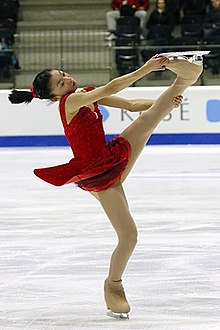
| Figure skating element | |
|---|---|
| Element name | Spin |
| Scoring abbreviation | Sp |
Spins are an element in figure skating in which the skater rotates, centered on a single point on the ice, while holding one or more body positions. They are performed by all disciplines of the sport, single skating, pair skating, and ice dance, and are a required element in most figure skating competitions. As The New York Times says, "While jumps look like sport, spins look more like art. While jumps provide the suspense, spins provide the scenery, but there is so much more to the scenery than most viewers have time or means to grasp".[1] According to world champion and figure skating commentator Scott Hamilton, spins are often used "as breathing points or transitions to bigger things".[1]
Figure skating spins, along with jumps, spirals, and spread eagles were originally individual compulsory figures, sometimes special figures. Unlike jumps, spins were a "graceful and appreciated"[2] part of figure skating throughout the 19th century. They advanced between World War I and World War II; by the late 1930s, all three basic spin positions were used.
There are two types of spins, the forward spin and the backward spin. There are three basic spin positions: the upright spin, the sit spin, and the camel spin. Skaters also perform flying spins and spin combinations. The International Skating Union (ISU), figure skating's governing body, delineates rules, regulations, and scoring points for each type and variety of spin.
- ^ a b Cite error: The named reference
clareywas invoked but never defined (see the help page). - ^ Hines 2006, p. 103.